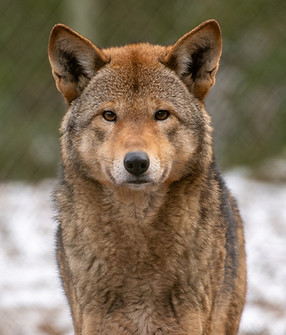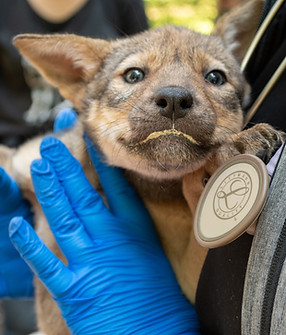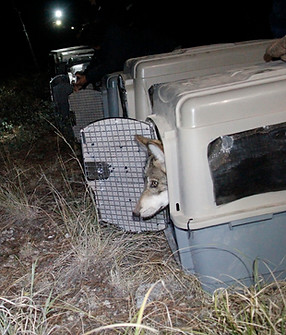endangered species
Saving Animals From Extinction (SAFE) programs are a cooperative effort between the U.S. Fish and Wildlife Service and the Association of Zoos and Aquariums. Originally called Species Survival Plan (SSP) programs, these recovery efforts are designed to oversee the population management of an endangered species in captivity and enhance their conservation in the wild. The SSP program was developed in 1981 and transitioned into SAFE in 2023. Wolf Haven participates in two federally managed SAFE programs designed to ensure the continued health and survival of the American Red Wolf and Mexican wolf.

American Red Wolves
(Canis rufus)
The American Red Wolf is one of two wolf species indigenous to North America. The original American Red Wolf range extended throughout the southeast, up and down the eastern seaboard, and as far west as Texas, Missouri, and Arkansas. Aggressive predator control and habitat loss reduced the wild American Red Wolf population to a mere 14 wolves by the late 1970s.
However, the most serious threat to the existence of American Red Wolves was hybridizing with coyotes. As gray wolves were eradicated, coyotes experienced a population explosion and radically expanded their range east. Simultaneously, as the American Red Wolf population fell, coyotes and American Red Wolves began to interbreed. By the late 1960s, there were very few true American Red Wolves remaining.
The Endangered Species Act prevented the complete eradication of the American Red Wolf, and an American Red Wolf Species Survival Plan (SSP) program was developed by the U.S. Fish and Wildlife Service to manage and oversee the recovery of this endangered species through captive breeding, housing, and releasing into suitable habitat. In 2023, the SSP program transitioned into a Saving Animals From Extinction (SAFE) program.
Of the 400 animals captured between 1973 and 1980 to start the recovery program, 43 were sent to the first breeding facility: Point Defiance Zoo in Tacoma, Washington. Only 14 of those 43 were eventually determined to be pure American Red Wolves (rather than coyote hybrids) and were used to establish the population of American Red Wolves that exists today. The first captive-born American Red Wolves were born in 1977, and the first American Red Wolf reintroduction took place in 1987.
Today, the SAFE American Red Wolf population under professional care includes 280 wolves living in 49 facilities across the United States. But fewer than 30 American Red Wolves are estimated to roam their native habitat in the Alligator River National Wildlife Refuge and the Pocosin Lakes National Wildlife Refuge in North Carolina. This remains the only wild population of American Red Wolves in the world.

Mexican Wolves
(Canis lupus baileyi)
The Mexican wolf is the most genetically distinct subspecies of the gray wolf. They are smaller than other gray wolf subspecies, with multicolored coats, long mane-like hair around their neck, long legs, and thick ears with rounded tips.
In the early 1900s, hunting increased and ranching expanded throughout North America. The natural prey species of the Mexican wolf were replaced by cattle and sheep, creating a tragic situation for the wolves. Livestock depredations gave ranchers and government officials in the United States and Mexico a reason to initiate a series of strategies to kill wolves. Once abundant in the mountains of Mexico, Arizona, New Mexico, and Texas, the Mexican wolf nearly went extinct by the early 1970s.
The Endangered Species Act prevented the complete eradication of the Mexican wolf, but their population was so low at the time that wildlife officials felt the only option for the restoration of this subspecies was captive breeding and reintroduction to historical ranges.
A Mexican Wolf Species Survival Plan (SSP) program was developed by the U.S. Fish and Wildlife Service (USFWS) to manage and oversee a breeding program and to lend support to the reintroduction and recovery efforts of the species in the wild. Roy McBride, an experienced wolf trapper, was hired by USFWS to remove the last individuals remaining in the Mexican wild.
After many difficulties, he was able to trap five wolves, three of which were selected based on their genetic characteristics for the SSP program. They came to be known as the McBride lineage. An additional four Mexican wolves from two distinct lineages – Ghost Ranch and Aragón – were found living in captivity and added to the founding SSP population. These seven wolves would come to be the founders for the entire breeding population.
In 2023, the SSP program transitioned into a Saving Animals From Extinction (SAFE) program. Only 311 Mexican wolves are known to be living in the wild today, mainly along the Arizona-New Mexico border. An additional 338 Mexican wolves live under professional care in 60 facilities across the United States and Mexico.

safe at wolf haven
Wolf Haven has participated in the Mexican Wolf Recovery Program since 1994 and the American Red Wolf Recovery Program since 2003. Because of the secluded nature of our sanctuary, the wolves who are raised here are prime candidates for release into the wild. Pre-release enclosures are designed to prepare wolves for life in the wild, and meet the size, space, and privacy requirements outlined by the program. Interactions with humans are kept to a minimum and observations are done by remote camera.
There are currently 19 Mexican wolves and seven American Red Wolves living at Wolf Haven as part of their respective Saving Animals From Extinction (SAFE) programs. To date, ten litters of Mexican wolf pups and five litters of American Red Wolf pups have been born in the sanctuary. The most recent litter was born in the spring of 2023.
Our participation in these two recovery programs provides us with the opportunity to teach about the historical and current ranges of the American Red Wolf and Mexican wolf; support conservation efforts; and sustain a surplus population of animals who are behaviorally and genetically appropriate for restoring the species in the wild if it were to go extinct.
Wolf Haven also had the opportunity to host the annual binational SSP/SAFE Mexican Wolf Meeting in 2012, where delegates from the United States and Mexico came together to discuss the status of the Mexican wolf recovery plan and made recommendations for breeding, transfers, and releases.

from the sanctuary to the wild
In 1998, three packs of Mexican wolves were released into Arizona’s Apache National Forest after being absent from the wild for nearly 30 years. One of those packs — the Hawk’s Nest pack — came from Wolf Haven. They successfully hunted an elk in less than a week and two years later, produced the first litter of pups conceived and born in the wild since their near-extinction decades earlier.
In 2000, another pack from Wolf Haven — known as the Cienega pack — was transferred and released into the wild in Arizona. A third pack release from Wolf Haven took place in 2016, as animal care team members Wendy Spencer & Pamela Maciel Cabañas transported 11 Mexican wolves from Washington into the mountains of northern Mexico.
In 2021, American Red Wolf F2216 (born at Wolf Haven in 2017) was released into the wild in North Carolina, becoming the first American Red Wolf from Wolf Haven to be released into the wild and one of the first adult releases since 1995! A few short years later, in 2024, American Red Wolf M2191 (born at Wolf Haven in 2016) was also released into the wild in North Carolina, where he integrated into the Milltail pack and produced two litters of pups. His release and breeding success was featured on NPR & BBC. M2191 continues to live, breed, and thrive on the landscape today.


.jpg)

